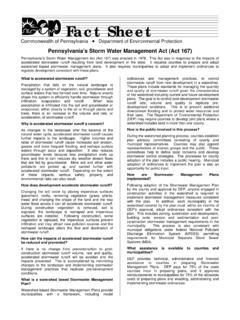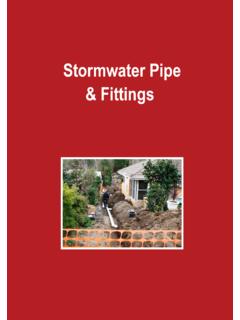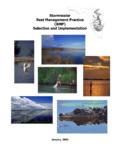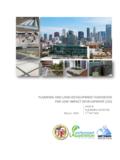Transcription of Stormwater Guidelines - saskh20.ca
1 Stormwater Guidelines EPB 322. January 2014. Preface Under The Environmental Management and Protection Act, 2002 (EMPA) and The Water Regulations, 2002; Stormwater quality and most aspects of its management at present is not specifically regulated. The purpose of this guideline is to provide a high-level technical guidance to municipal authorities, individuals and consultants who plan to develop and implement drainage systems for Stormwater in urban/built-up municipal areas, commercial and industrial areas in Saskatchewan. Although the Guidelines provide technical and practical guidance, users must exercise judgment in planning, designing and implementing Stormwater management works. Stormwater management solutions are site specific, which must be recognized when using the guidance provided in this document. The designer has to determine if a single practice or a combination of practices are needed to meet the Stormwater objectives and goals for any given site and is responsible for the design and decisions made with respect to Stormwater management.
2 The Water Security Agency (WSA) encourages the development and use of novel designs and best available technologies in developing Stormwater management solutions. The WSA believes that the Guidelines , when employed as a Code of Practice will aid minimizing the impacts on receiving waters due to Stormwater discharges and may serve as a diligent approach to improved Stormwater management in the province. Table of Contents Page 1. Rationale and Background for Stormwater Management Guidelines 2. 2. Stormwater Quantity and Quality 3. General 3. Stormwater Quantity 3. Stormwater Quality 5. 3. Stormwater Management Practices and Guidelines 6. General 6. Source Controls 7. On-site (Lot-level) and Conveyance System Controls 8. On-site (Lot-level) Controls 8. Reduced Lot Grading 8. Roof Leader to Ponding Areas and Rooftop Storage 9. On-lot Infiltration System 9.
3 Sump Pumping of Foundation Drains 10. Conveyance System Controls 11. Pervious Pipe Systems 11. Pervious Catchbasins 11. Grassed Swales 12. Vegetated Filter Strips 13. End-of-pipe Controls 13. Wet Ponds 13. Dry Ponds 15. Constructed Wetlands 16. Infiltration Trench 16. Infiltration Basin 18. Sand Filters 18. Oil/grit Separators 19. APPENDIX A 20. References 22. 1. 1. Rationale and Background for Stormwater Management Guidelines Stormwater is rainfall and snowmelt that runs off the land into storm sewers, streams and nearby lakes or rivers. The degradation of water quality has received increasing attention over the past several decades. The cause of degradation may be attributed to point sources of pollution such as wastewater treatment plants or industrial waste discharges. Although a great deal of progress has been made to minimize or eliminate point sources of pollution, water quality degradation of some watercourses may occur due to non-point pollution such as Stormwater runoff.
4 It is recognized that urbanization increases the quantity of localized Stormwater runoff and affects the quality of water in receiving water bodies, thereby resulting in significant environmental impacts, which affect aquatic habitats of receiving waters. Environment Canada has estimated that urbanization of a natural drainage basin can result in increases in Stormwater runoff of 400 per cent or more. Where urbanization occurs, undisturbed pervious surfaces become impervious with the construction activities. Impervious surfaces produce an increase in Stormwater runoff, both quantitatively and qualitatively. It is anticipated that these changes may cause pollution in receiving waters, affect the aquatic habitats and their functions, disrupt the natural balance of physical, chemical and biological processes, result in soil erosion that creates damage downstream, reduces infiltration of water into the ground and in extreme cases may also causes flooding.
5 Municipal Stormwater collection systems discharge many substances in addition to water. As Stormwater collects and flows over pavement, lawns, driveways and other urban surfaces; it collects considerable quantities of pollutants such as oil and grease, fertilizers, pesticides and metals. Sediment from active construction sites often discharges into storm drainage systems. Private citizens may also contribute to Stormwater pollution by improper disposal of lawn clippings, used oil or household chemicals. Industrial and commercial facilities may discharge pollutants into Stormwater collection systems through cross- connection of storm drains and sanitary sewers. Under The Environmental Management and Protection Act (EMPA) and The Water Regulations Stormwater quality and most aspects of its management at present is not specifically regulated.
6 Neither EMPA nor The Water Regulations presently require a permit for the construction or operation of a dedicated Stormwater works. However, EMPA does provide authority for the creation of regulations governing Stormwater by virtue of: 81(1)(bbb) respecting storm water and storm water works, including prohibiting any matter or action related to storm water works and protecting the environment as it is affected by storm water and requiring the holding of a permit to do any matter or undertake any action related to storm water works and protecting the environment as it is affected by storm water;. The Water Regulations define Stormwater as: 2(1)(gg) storm sewer means a system of conduits, drains, mains, manholes, basins and pipes intended to convey storm water exclusively or principally. The Water Regulations only prohibit the permittee of a sanitary sewage works from interconnecting a sanitary sewers and storm sewers by means of Section 14 as follows: 14 No permittee shall cause any sanitary sewers and storm sewers to be interconnected in a manner that permits sewage in the sanitary sewer to be discharged through the storm sewer.
7 Prior to the revisions to water related legislation in 2002, the management of Stormwater was specifically exempted from permitting by clause 6(1)(d) of The Water Pollution Control and Waterworks Regulations which state: 6(1) The following discharge of contaminants are exempted from Clause 17(a) of the Act: 2. (d) any storm water discharge other than storm water discharge at any industrial operation that has a permit pursuant to clause 17(a) or 17(c) of the Act. Interconnection of Stormwater and sanitary sewers was also prohibited under the former Water Pollution Control and Waterworks Regulations that was in effect from 1987 to 2002. Although management aspects of Stormwater management are presently limited as outlined above, section 4(2) of EMPA prohibits discharges that may cause or is causing an adverse effect as follows: 4(2) No person shall discharge or allow the discharge of a substance into the environment in an amount, concentration or level or at a rate of release that may cause or is causing an adverse effect unless otherwise expressly authorized pursuant to: (a) this Act or the regulations.
8 (b) any other Act, Act of the Parliament of Canada or the regulations made pursuant to any other Act or Act of the Parliament of Canada; or (c) any approval, permit, licence or order issued or made pursuant to: (i) this Act or the regulations; or (ii) any other Act, Act of the Parliament of Canada or the regulations made pursuant to any other Act or Act of the Parliament of Canada. Pollution resulting from Stormwater runoff carries the potential to affect the quality of water and environment in natural receiving systems. The WSA believes it is essential to develop and implement Stormwater Management Guidelines ' as a Code of Practice for municipal authorities, individuals and consultants who plan to develop and implement drainage systems for Stormwater in urban areas, commercial and industrial areas. Voluntary observance of these Guidelines will then serve as a diligent.
9 Approach to improved Stormwater management in the province and thereby avoid the potential consequences of adverse impacts to aquatic ecosystems. 2. Stormwater Quantity and Quality General Stormwater quantity is variable in duration, frequency and location. The amount of Stormwater runoff reaching a receiving water body will also depend upon the surface over which it travels. An increase in Stormwater runoff in urban areas results in increased peak flows, which must be determined in order to design and implement any Stormwater works. The quality of Stormwater runoff is often a function of several mechanisms and the type and amount of pollutants in runoff are associated with a given land use or activity. As the case with the design of any wastewater treatment works, the incoming quality of Stormwater runoff must be known prior to designing any Stormwater works.
10 Stormwater Quantity The hydraulic sizing of drainage and conveyance structures in urban areas always requires estimation of peak flow rates. Peak flow is the maximum rate of flow passing a given point during or after a rainfall event. Historically, the Rational Method is the most widely used method of estimating the peak runoff rates for the design of urban drainage systems. The Rational Method is based on an empirical formula relating the peak flow rate to the drainage area, the rainfall intensity and a runoff coefficient. The Rational formula is: 3. Q = C I A (m /s) [Metric units], or 3. Q = C I A (ft /s) [British units]. Where Q = peak runoff rate C = dimensionless runoff coefficient I = rainfall intensity for a duration that equals time of concentration (tc) of the basin (mm/hr and in/hr in metric and British units, respectively). A = basin area (hectares and acres in metric and British units, respectively), and tc = time of concentration for the basin for the particular event (min).







